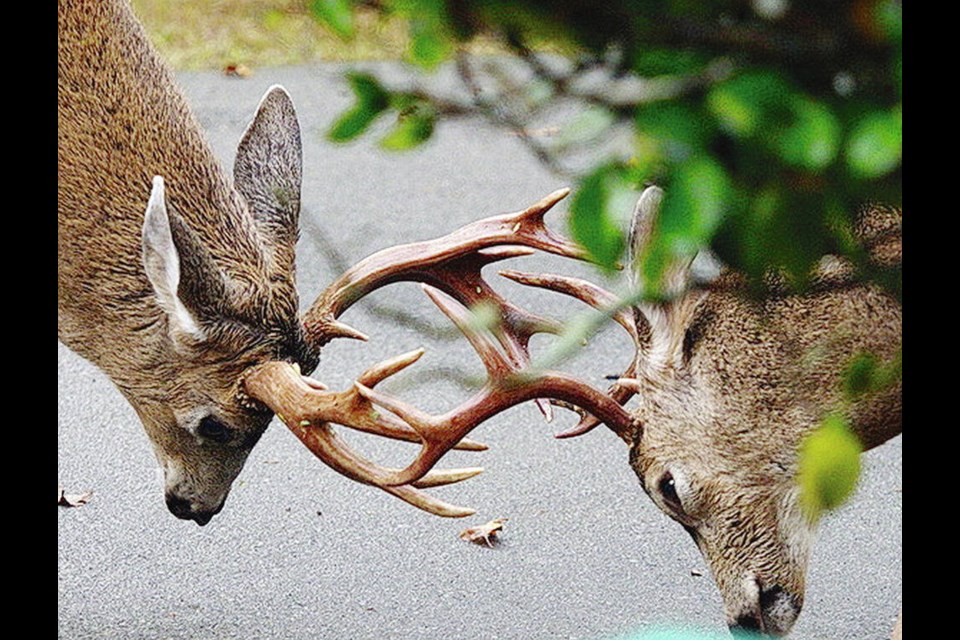Anne Christiansen got a front-row seat to rutting bucks in action this week.
The senior was driving home from a social event in the Uplands when she came upon two blacktail bucks locking antlers on a boulevard, tearing up the grass and grunting loudly as they fought for dominance.
“I slowed right down to a crawl because you never know what those aroused fellows are going to do,” said Christiansen, 73.
“The next thing I knew, one of them was bounding toward my car, jumped right over and across my windshield, which miraculously did not break.”
The fleeing buck did take off a windshield wiper, leaving a muddy smear on her windshield and a breathless moment of realization of the dangers and unpredictability of those muscular and heavy bucks.
“It could have been much worse,” said Christiansen. “I thought it was going to come right through the windshield, but there wasn’t a scratch on the car.”
Male deer wandering our urban environment have one thing on their minds this time of year — fighting for female mates.
They are singular in focus, says Vanessa Isnardy, program manager for WildSafeBC.
She says the bucks often don’t eat during the rut and practise fighting on trees and shrubs, often tearing them apart, with little regard to what or who is around.
The rut started in earnest in late October and is likely now at its peak, which will last to mid-November, says Isnardy.
She says anyone walking around in the evening should be alert, especially with the time change upon us and darkness falling earlier.
Isnardy recommends not using ear buds on evening walks because rutting fights can break out anywhere, and for dog walkers to keep a tight leash on pets.
“The bucks are focused and may see people as a potential rival,” says Isnardy. “Give them lots of space and don’t approach them. People often want to take photos, but that’s not a good idea.”
If you come in close proximity to a buck, get behind a tree or a car and slowly back away, she says. It’s the same advice WildSafeBC provides to anyone encountering moose.
Drivers should also slow down in areas where deer are common, as fights can spill over into traffic, and wandering bucks are not aware of vehicles. “There is potential for deer to be hit by cars this time of year because where there’s one, there’s usually others,” she said.
A post on the Facebook group Oak Bay Local on Wednesday showed a “traffic jam” on Fairfield Road as a buck followed a doe for several hundred metres down the middle of the street, slowing traffic to a crawl. One person commented: “Lots of deer running around being naughty … nearly knocked me off my bike.”
Oak Bay resident Brian Eccles has been filming the rut for three years in Greater Victoria after moving from Haida Gwaii 10 years ago.
“They have one thing on their minds — love — and they are very single-minded in that regard,” said Eccles. “They’re buzzing around trying to corral females and [to] anyone who gets in their way, it’s ‘here’s my horns, let’s go.’
“It’s really quite dramatic with all the grunting going on and a lot of power … they’re 150 pounds each and really smashing into each other. You don’t want to be close to that.”
Eccles warned pet owners, walkers and drivers to be vigilant. Fights can break out anywhere, and aggressive behaviour where bucks practise their antler antics can destroy your rhododendrons and saplings and rip bark off trees.
“In places where there are lots of deer, they can just bound out in front of you,” said Eccles. “You can pull your dog back, but you never know what they will do.
“There are two times a year when you have be really careful around deer: in the spring when does are protecting their fawns, and right now during the rut.”
The aggressive behaviour often leaves bucks with debris stuck to their antlers — everything from clotheslines to badminton nets, garden netting and pieces of wood, all of which causes the animals extra stress.
Last fall, conservation officers were called to several areas in the region to tranquilize bucks and remove antler junk. In the Mount Tolmie and Fairfield areas, two pairs of bucks had to be tranquilized after their antlers were locked together and entangled — in one case by a pole and garden netting, in the other by a driftwood sculpture.
The numbers of deer roaming Greater Victoria is difficult to pinpoint, but everyone agrees there are plenty chewing on plants and gardens. A contraceptive program for female deer that began in 2019 in Oak Bay is showing a drop in the number of fawns, according to researchers. A similar research project has also been launched in Esquimalt.

-05-18_at_35540_pm.jpg;w=120;h=80;mode=crop)



